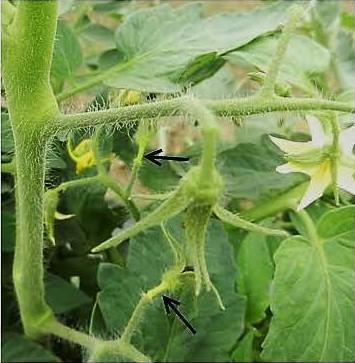Expect Poor Fruit Set in Tomatoes This Week

This heat wave we have had this past week will have repercussions over the next few weeks as the flowers of several crops including cucurbits, peppers and especially tomato will not pollinate or fertilize properly to develop into fruit. Daytime highs of 90° F and above and nighttime lows only getting down to 70° F in much of the mid-Atlantic for the last week will cause blossom drop and fruit abortion in tomatoes. Normally tomato pollination is achieved by the action of the wind. Pollen is released from the tomato flower and falls downward onto the stigma. Without pollination flowers die and drop. In tomatoes, blossom drop is usually preceded by the yellowing of the pedicel (fig. 1). Tomato flowers must be pollinated within 50 hours of formation or they will die. This is about the time it takes for the pollen to germinate and move up the style to fertilize the ovary. Tomato plants can tolerate extreme temperatures for short periods, but several days or nights with too high of temperatures will cause the plant to abort flowers and fruit (fig. 2). At these high temperatures the pollen can become sticky and nonviable, preventing pollination from occurring and causing the blossom to dry and drop. Relative humidity also plays a role in pollination with high levels (>80% RH) (which we had this week) during pollen shed causing the pollen not to be released properly resulting in poor or incomplete pollination.
Most tomato cultivars can make up for this set back of low fruit production with increased flower formation once it cools a bit. It may help to have some cultivars that are better able to take the high temperatures and humidity without as much flower/fruit abortion. Cultivars such as Solar Set, Solar Fire, Sunmaster, Florida 91, Sunchaser for hybrid determinates and for heirlooms Arkansas Traveler, Homestead 24 and Hazelfield Farm are a few but certainly not all the possible tolerant varieties that have been bred to perform better in the heat.
